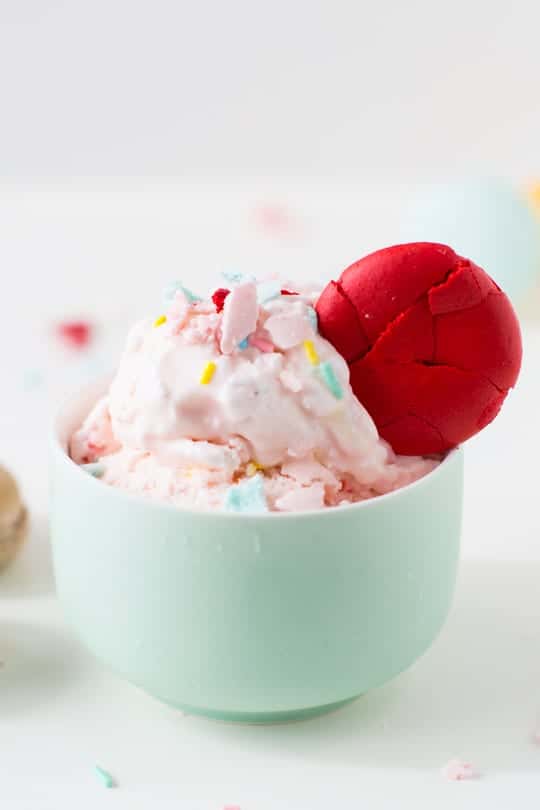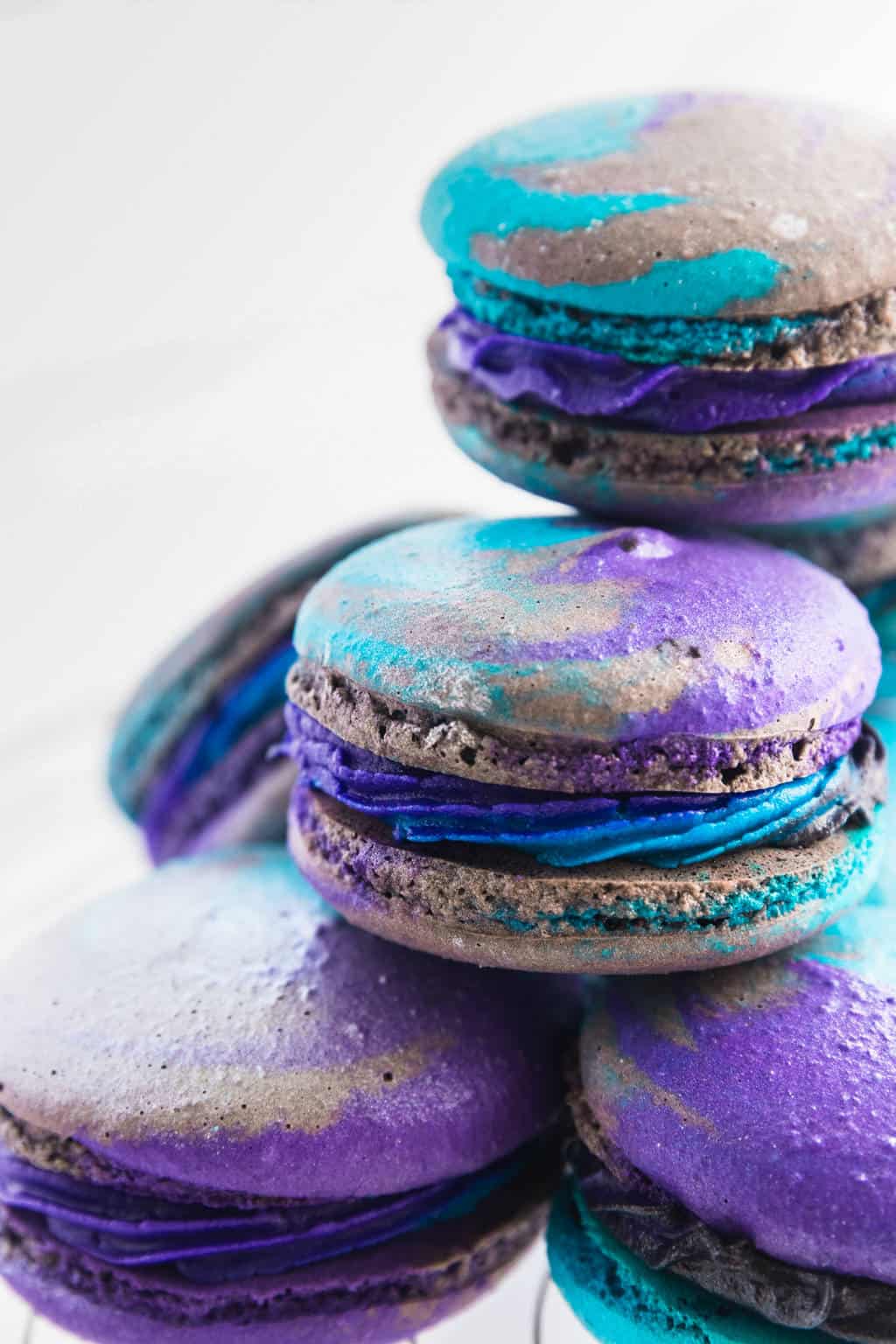Italian Macarons Recipe
Learn how to make the most delicious Italian macaron recipe, which is made with meringue powder. This easy and quick dessert recipe will be a hit at your next party!
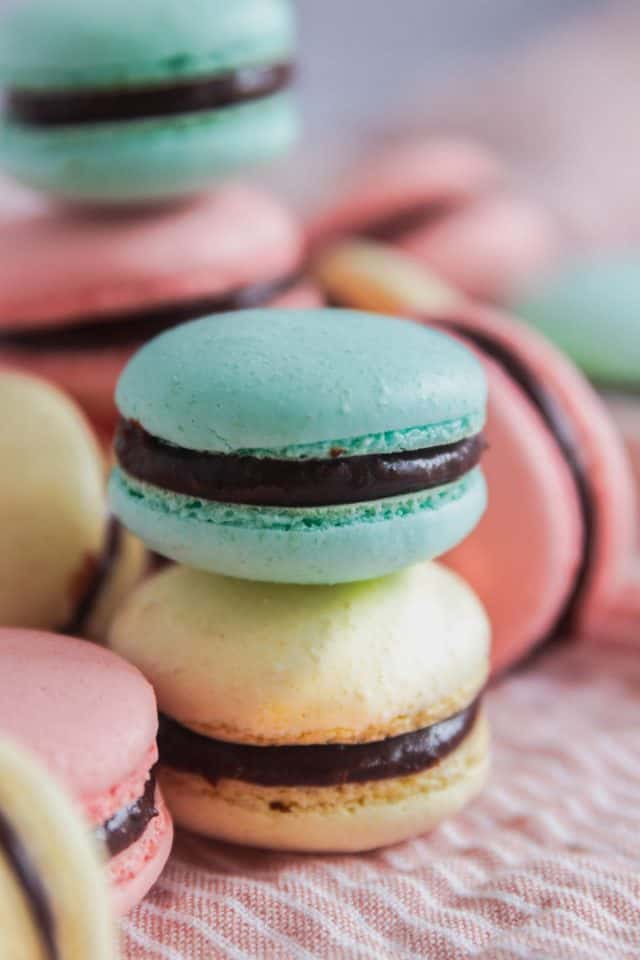
Macarons, the classic sandwich cookie, are made using the Italian meringue method in this recipe for a macaron that’s a bit sturdier than their French cousin. As if macarons weren’t fancy enough, did you know there’s more than one way to make them?
While there’s already a whole tutorial on this site for making macarons with a French meringue, the Italian meringue method is another great option if you’re feeling adventurous in the kitchen. Interested in making a colorful meringue? Check out Holiday Wreath Meringue Macarons!
Tools You’ll Need to Make Italian Macarons Recipe
- Digital baking scale that weighs in grams
- Stand mixer
- Digital thermometer or candy thermometer
- Piping bags and round couplers
How To Make Italian Macarons Recipe
Step 1 – Separate 3 egg whites. Place 45 grams of the egg whites in your stand mixer’s bowl, and set aside another 45 grams in a separate bowl.
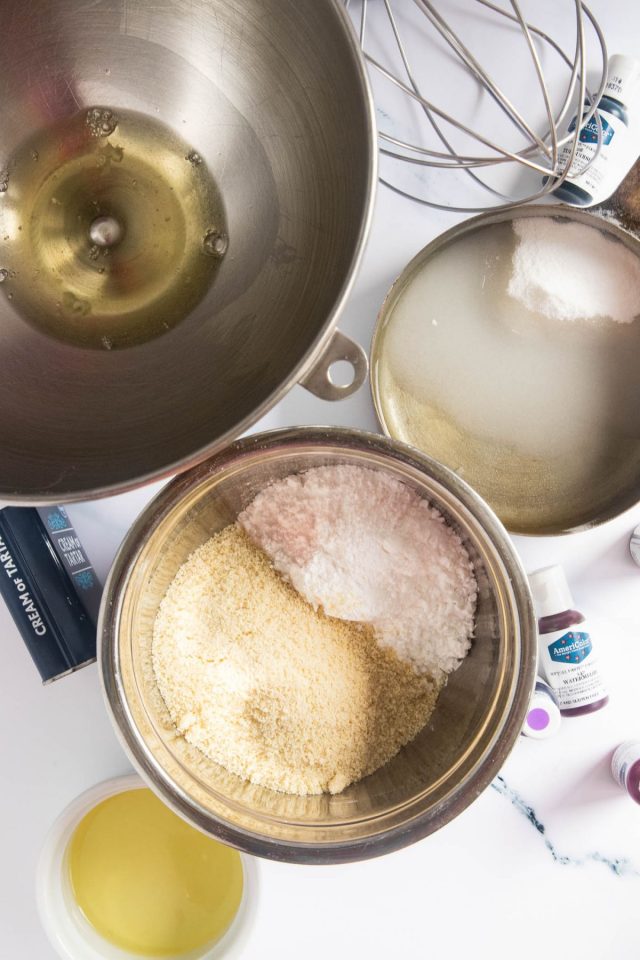
Step 2 – Weigh out 112 grams (1 cup) of blanched almond flour and 118 grams (1 cup) of powdered sugar.
Step 3 – Sift them through a strainer into a clean bowl. This process removes any lumps or large bits from the dry ingredients to give you a smoother macaron batter.
Step 4 – Add 45 grams of egg whites and 1 teaspoon of vanilla to the almond flour and powdered sugar. Stir together until you have a paste.
You can also try our classic Italian meringue buttercream frosting which is a lightly sweetened, silky smooth icing that’s perfect for piping flowers or spreading on a cake or cookies.
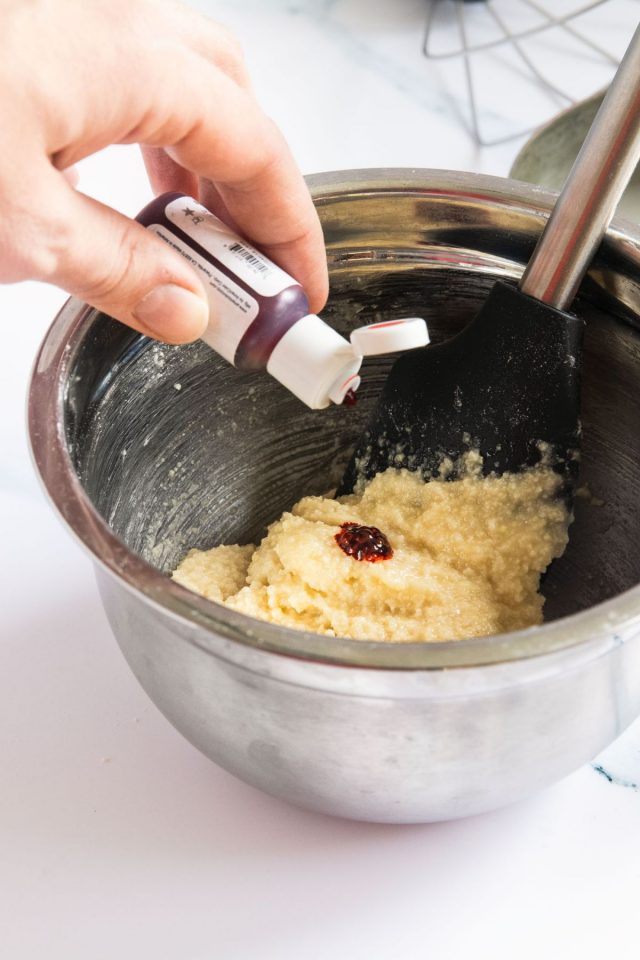
If you wish to make colored macarons:
Stir up to 1/4 teaspoon of gel food coloring into the almond flour paste.
Avoid using liquid food coloring as it can add too much liquid to the batter. This then results in a runny macaron batter.
Make sure the color is darker and brighter than you want your final macarons to look. The final batter color will turn out significantly lighter after folding in the meringue.
Combine 112 grams (1 cup + 1 tablespoon) of granulated sugar with 80 grams (1/3 cup) of water in a small pot, and heat it over medium heat.
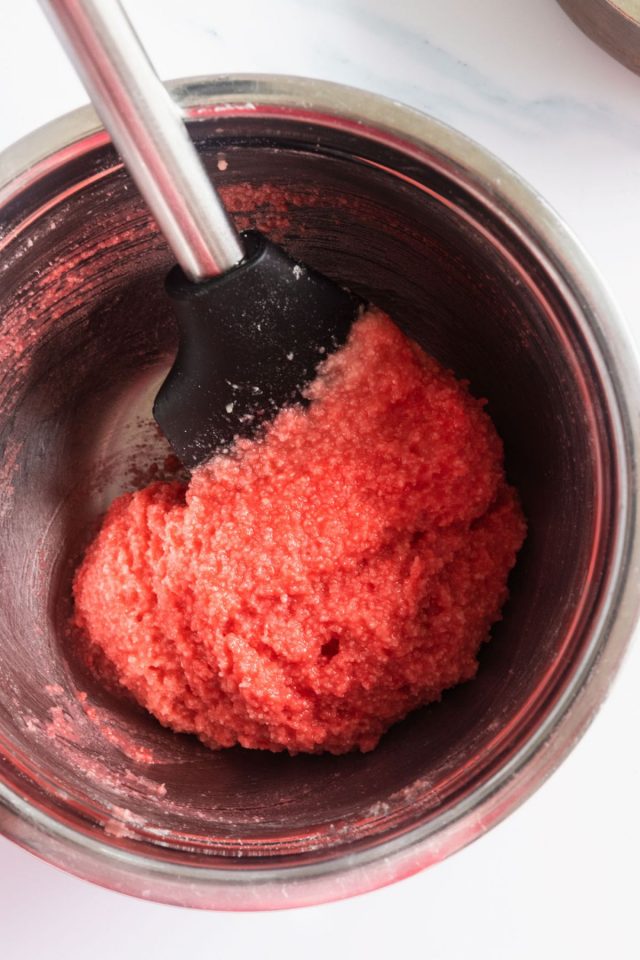
While the sugar syrup is heating, add ¼ teaspoon of cream of tartar to the egg whites in the stand mixer bowl and beat it until it comes to soft peaks.
This means that when you lift a spoon or beater it leaves behind a soft point in the meringue.
If the egg whites reach the soft peak stage before the sugar syrup is ready, turn down the mixer speed to low and keep mixing so that the egg whites don’t sit and separate.
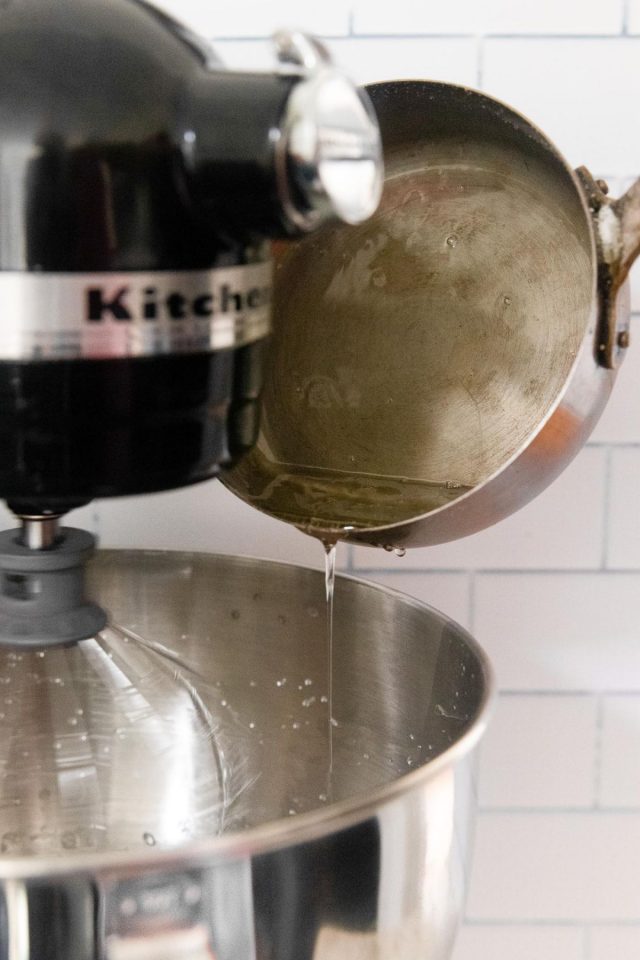
The soft ball stage:
- Continue heating the sugar syrup until it reaches 234-240°F. This is called the soft ball stage and may be marked that way on your candy thermometer).
- Once it is the correct temperature, turn the mixer speed up to medium-high and slowly pour in the sugar syrup. *Note: Some of the sugar syrup will end up splattered on the sides of the bowl. This is unavoidable and quite alright.*
- Continue whipping the meringue until has reached the stiff peak stage. This means that when you lift a spoon or beater from the meringue, a stiff point is left from the end of it that doesn’t droop or fall over. This is an Italian meringue.

The macronage stage:
Add about one-third of the meringue to the almond flour paste, and use a rubber spatula to stir until completely combined.
It may seem like all of the air is being deflated from the meringue, but that’s okay!
This step is actually creating a consistency that allows the rest of the egg whites to be folded in without deflating.
This step is called the macronage and is how you achieve the correct consistency for your final macaron batter.
Once the first portion of the meringue is mixed in, add another 1/3 of the meringue. Again, fold it in until well combined.
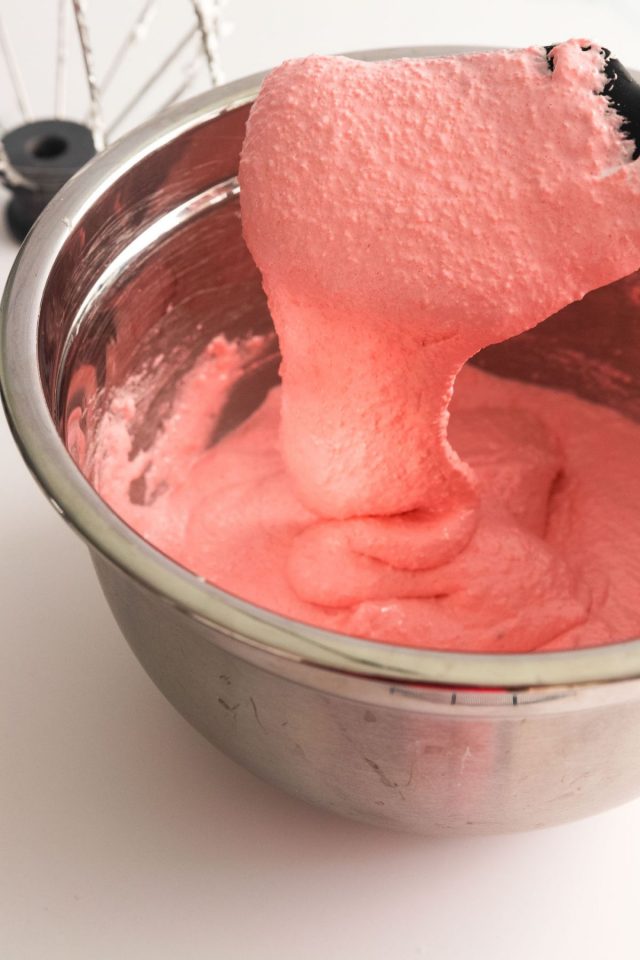
Finally, add the last third of the Italian meringue and fold it in gently until there are no streaks left in the batter. Keep folding until the batter runs off your spatula in thick ribbons.
You should see the bit that just ran off of your spatula sit on top of the batter for a count of 8-10.
If it hasn’t melded into the rest of the batter after that, continue mixing for a few more folds, then test it again.
Line a couple of large baking sheets with clean parchment paper and set them aside.
To pipe your macarons:
- Place the macaron batter in a clean piping bag fitted with a round coupler or a large round tip and spoon the batter into it.
- Hold the piping bag straight up and down over the parchment paper.
- Squeeze to the count of three.
- Stop applying pressure to the bag and lift straight up.
- Continue this step until your batter is piped over the baking sheets. Be sure to leave 1 1/2 to 2 inches between each macaron cookie.
How to bake your macarons:
- Preheat your oven to 325°F.
- Set the piped macarons out to dry for 30 minutes. Allowing the tops to dry slightly gives the macaron shells something to lift up under and helps macaron feet develop during baking.
- Bake the macaron shells for 10-12 minutes, rotating the pan halfway through the baking time.
- Remove the baked macaron shells from the oven. Allow them to cool completely before filling.
- Fill the macarons with a filling of your choice. A chocolate ganache contrasts nicely with the sweetness of the shells. Buttercream or jam also makes a great filling! Allow the filled macarons to sit for a while, preferably overnight. Store them in the refrigerator.
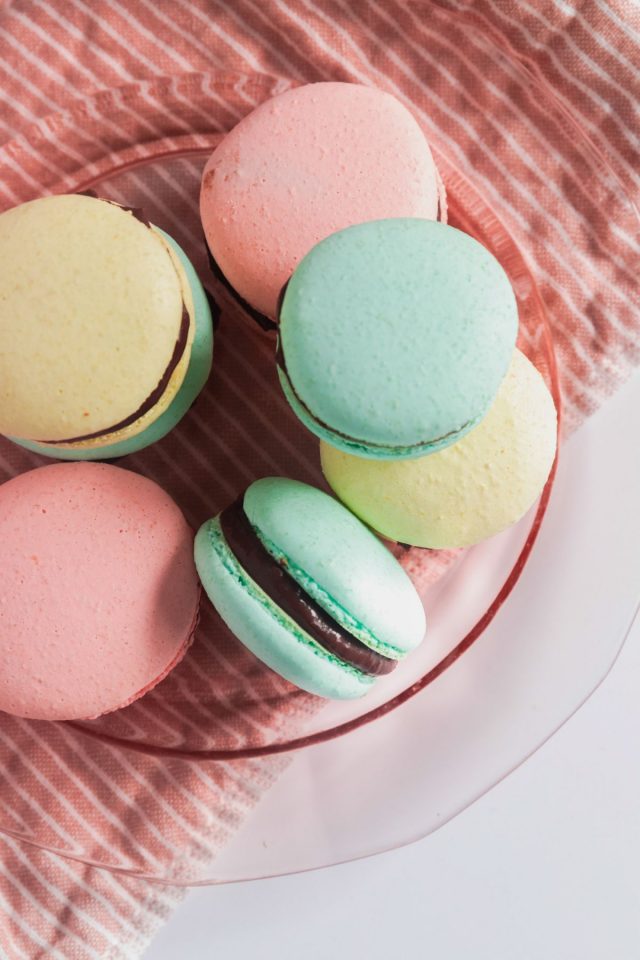
Pros and Cons of Italian Meringue Macarons vs. French Meringue Macarons
Italian meringue is a bit sturdier than French, which means that you’re less likely to over-fold the batter when you get to the macronage stage.
French meringue is a lot simpler to make. You just slowly beat granulated sugar into egg whites to make your meringue. On the other hand, Italian meringue is cooked by beating sugar syrup heated to 140°F into your egg whites. This technique gives you a more stable meringue that’s less likely to deflate. But it also can be a bit tricky to get right and requires more equipment.
French meringue macarons don’t require any special equipment beyond a hand mixer and baking scale. To make Italian meringue macarons, you’ll also need a candy thermometer and stand mixer.
Italian macarons tend to be more consistent. They are easier to work with and the batter is less finicky than the French variety.
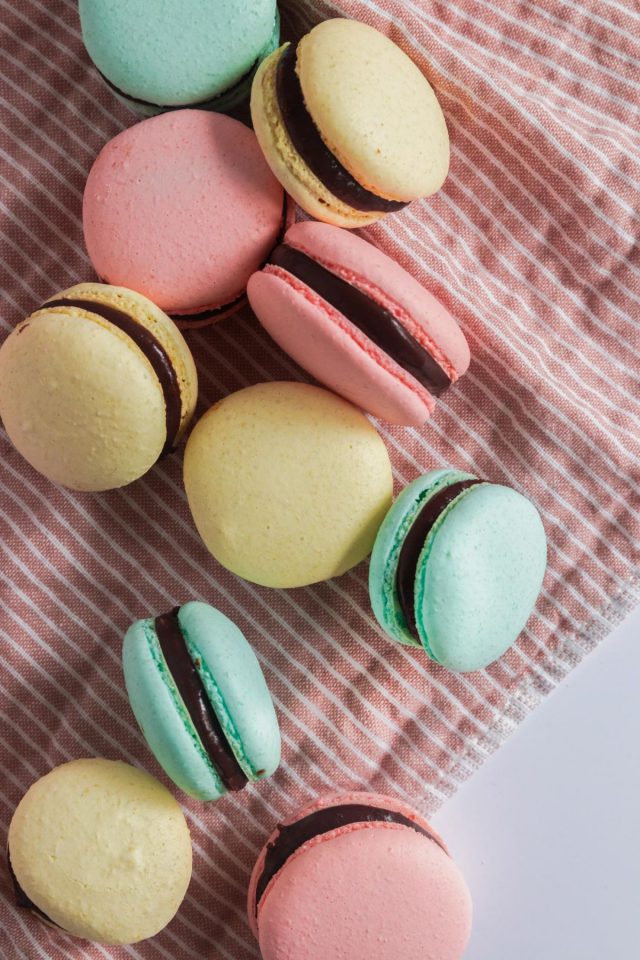
Tips for Successful Macarons
- Grease of any kind will break down the meringue in your macaron batter and make them runny and ruined. It’s a good idea to wipe down your bowls and tools with vinegar to break down and remove any build-up or grease before using them.
- Printing off a macaron template can be a great way to pipe macarons that are identical in size and shape.
- After piping the macarons, be sure to let the macarons sit for a full 30 minutes before baking.
- To make sure your oven is baking at the correct temperature, try to use a simple oven thermometer and adjust your oven to match it. For example, if your oven says it’s preheated to 325°F but it’s reading 10° hotter or cooler on your oven thermometer, it can cause your macarons to scorch, not rise correctly, and cause other problems.
- While there are volume measurements (cups, teaspoons, etc.) provided in the recipe, a digital baking scale is highly recommended for macarons. It will help you have more consistently successful results.
Check Out Other Unique Macarons Recipes
- Macarons Recipe: How To Make Macarons
- Easy Halloween Dessert: DIY Ghost Macarons
- Jumbo DIY Paper Mache Macarons
- DIY Boob Macarons & Valentines Printables
- DIY Lucky Charms Macarons For St. Patrick’s Day
- An Ode To Macarons & Happy National Macaron Day!
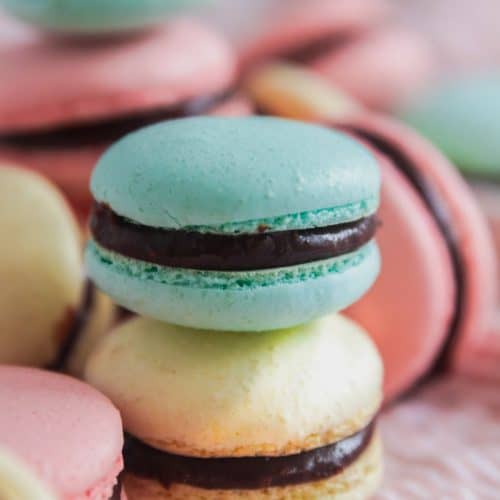
How to Make Italian Macarons
Equipment
- Digital baking scale that weighs in grams
- Stand mixer
- Digital thermometer or candy thermometer
- Piping bags and round couplers
- Strainer
- Small pot
- Rubber spatula
- Baking sheet
Ingredients
- 3 egg whites (90 grams, divided into two 45 gram portions)
- ¼ tsp cream of tartar
- 112 g blanched almond flour (1 cup)
- 118 g powdered sugar (1 cup)
- 1 tsp vanilla extract
- 1/4 tsp gel food coloring
- 112 g white granulated sugar (1 cup + 1 tbsp)
- 80 g water (1/3 cup)
For the chocolate ganache filling:
- 1 cup chopped dark chocolate
- 1 cup whipping cream
Nutrition
Instructions
- Separate 3 egg whites. Place 45 grams of the egg whites in your stand mixer’s bowl, and set aside another 45 grams in a separate bowl.
- Weigh out 112 grams (1 cup) of blanched almond flour and 118 grams (1 cup) of powdered sugar. Sift them through a strainer into a clean bowl. This process removes any lumps or large bits from the dry ingredients to give you a smoother macaron batter.
- Add 45 grams of egg whites and 1 teaspoon of vanilla to the almond flour and powdered sugar. Stir together until you have a paste.
- If you wish to make colored macarons, stir up to 1/4 teaspoon of gel food coloring into the almond flour paste. Avoid using liquid food coloring as it can add too much liquid to the batter. This then results to a runny macaron batter. Make sure the color is darker and brighter then you want your final macarons to look. The final batter color will turn out significantly lighter after folding in the meringue.
- Combine 112 grams (1 cup + 1 tablespoon) of granulated sugar with 80 grams (1/3 cup) of water in a small pot, and heat it over medium heat.
- While the sugar syrup is heating, add ¼ teaspoon cream of tartar to the egg whites in the stand mixer bowl and beat it until it comes to soft peaks. This means that when you lift a spoon or beater it leaves behind a soft point in the meringue. If the egg whites reach soft peak stage before the sugar syrup is ready, turn down the mixer speed to low and keep mixing so that the egg whites don’t sit and separate.
- Continue heating the sugar syrup until it reaches 234-240°F. This is called soft ball stage and may be marked that way on your candy thermometer). Once it is the correct temperature, turn the mixer speed up to medium-high and slowly pour in the sugar syrup. Some of the sugar syrup will end up splattered on the sides of the bowl. This is unavoidable and quite alright.
- Continue whipping the meringue until has reached stiff peak stage. This means that when you lift a spoon or beater from the meringue, a stiff point is left from the end of it that doesn’t droop or fall over. This is an Italian meringue.
- Add about one-third of the meringue to the almond flour paste, and use a rubber spatula to stir until completely combined.It may seem like all of the air is being deflated from the meringue, but that’s okay! This step is actually creating a consistency that allows the rest of the egg whites to be folded in without deflating. This step is called the macronage and is how you achieve the correct consistency for your final macaron batter.
- Once the first portion of meringue is mixed in, add another 1/3 of the meringue, and again, fold it in until well combined.
- Add the last third of the Italian meringue and fold it in gently until there are no streaks left in the batter. Keep folding until the batter runs off your spatula in thick ribbons. You should see the bit that just ran off of your spatula sit on top of the batter for a count of 8-10. If it hasn’t melded into the rest of the batter after that, continue mixing for a few more folds, then test it again.
- Line a couple of large baking sheets with clean parchment paper and set them aside.
- Place the macaron batter in a clean piping bag fitted with a round coupler or a large round tip and spoon the batter into it.
- To pipe your macarons, hold the piping bag straight up and down over the parchment paper. Squeeze to the count of three. Stop applying pressure to the bag and lift straight up. Continue this step until your batter is piped over the baking sheets. Be sure to leave 1 1/2 to 2 inches between each macaron cookie.
- Preheat your oven to 325°F.
- Set the piped macarons out to dry for 30 minutes. Allowing the tops to dry slightly gives the macarons shells something to lift up under and helps macaron feet develop during baking.
- Bake the macaron shells for 10-12 minutes, rotating the pan halfway through the baking time.
- Remove the baked macaron shells from the oven. Allow them to cool completely before filling.
- Fill the macarons with a filling of your choice. A chocolate ganache contrasts nicely with the sweetness of the shells. Buttercream or jam also makes a great filling!
- Allow the filled macarons to sit for a while, preferably overnight. Store them in the refrigerator.
To make the chocolate ganache filling:
- Place the chopped dark chocolate in a mixing bowl.
- Heat the cream until it is steaming and has small bubbles around the edges but isn’t boiling.
- Pour the heated cream over the chocolate and allow it to sit for about 10 minutes.
- Stir the chocolate and cream until it is smooth and glossy, with no chunks of solid chocolate.
- Allow the ganache to cool and thicken before piping itonto the bottoms of half of the macaron shells. Gently press another shell onto the ganache. Your macarons are ready to eat!

Don’t forget to share your Italian macaron recipe with us on Instagram using the hashtag #sugarandclothloves. We always love seeing all of your creations! Looking for more quick and delicious recipes? Find them all right here!
34 Decadent Desserts for Valentine’s Day
Sweeten up your celebration with these irresistible desserts for Valentine’s…
Homemade Macaron Ice Cream Recipe
This irresistible homemade macaron ice cream recipe is a match…
Trick or Treat Yourself with These 31 Spooktacular Halloween Desserts
From spooky cupcakes to creepy cookies, discover the most delicious…
Continue Reading Trick or Treat Yourself with These 31 Spooktacular Halloween Desserts
Galaxy Macarons Recipe
If you’ve mastered macarons, Galaxy Macarons are a great way…
Please note that we may earn a commission for some of the above affiliate links. However, products featured are independently selected and personally well-loved by us!

